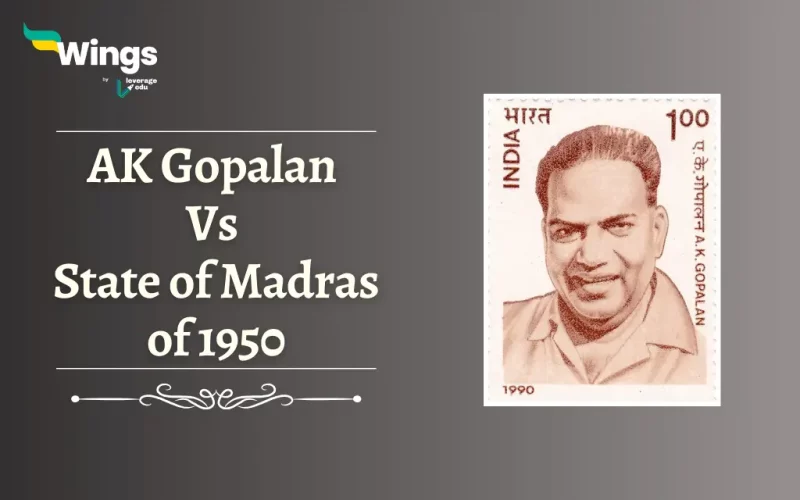The Supreme Court of India took up the landmark case of AK Gopalan Vs the State of Madras on the 15th of December 1950. This case particularly shaped Indian legal history by establishing a critical example of protecting citizens’ rights under the Preventive Detention Laws. Furthermore, the core of the case centred on the Preventive Detention Act of 1950, which empowered the government to jail people suspected of threatening our national security, without a trial. In addition, A.K. Gopalan who was a communist leader, challenged the law’s Constitutionality. Moreover, while the Supreme Court’s judgment was unanimous, it was different from the previous passage. The Court did not uphold the law in its totality. Instead, it established a framework for regulations on Preventive Detention, hence paving the way for future legal challenges.
| AK Gopalan Case of 1950 | |
| Case Name | A.K. Gopalan vs. State of Madras |
| Judgement Year | 1950 |
| Popular Name | Preventive Detention Case |
| Related Issue/Topic | Procedure Established by Law |
| Related Schedule/Article | Article 21 and Article 22 |
History of the AK Gopalan VS State of Madras Case of 1950
A.K. Gopalan was a prominent Indian communist leader who challenged his detention under the Preventive Detention Act of 1950.
- He argued that his imprisonment since 1947 without trial violated his Fundamental Rights.
- Even though the previous charges were dropped, the Madras government gave a fresh detention order in March 1950.
- Gopalan claimed this action ignored basic principles of a fair legal procedure, hence including the right to be heard.
- Moreover, using Article 32 of the Indian Constitution, Gopalan filed a Habeas Corpus petition against the detention order.
- He argued that it violated his Rights guaranteed by Article 14, Article 19, and Article 21.
- Additionally, Gopalan argued that the order was given spitefully.
- Gopalan’s central argument focused on interpreting the Procedure Established by Law within Article 21.
- He equated it to the Due Process of Law claiming that his case lacked proper legal procedures, thereby violating his Fundamental Rights.
Also Read: What is Doctrine of Severability?
What was the Judgement of the Supreme Court of India?
The Supreme Court of India judgment struck down Section 14 of the Preventive Detention Act of 1950. It violated the Fundamental Right to Freedom guaranteed under Article 22 of the Indian Constitution.
- However, the Supreme Court clarified that removing this Section would not change the Act’s overall purpose or structure.
- Consequently, the rest of the Provisions of the Act were kept.
- The judgment further explained that the “personal liberty” in Article 21 refers to the freedom from physical restraint or detention.
- Additionally, it highlighted that Article 21 protects people only against executive overreach, not legislative actions.
Also Read: What is the Difference between Procedure Established by Law and Due Process of Law?
What was the Impact of the Judgement?
In this landmark judgment, the Supreme Court of India interpreted Article 21 restrictively. This approach, emphasising the literal text of our Constitution, defined “law” within the Article as legislation passed by the State, not principles of Natural justice.
- Therefore, the Court differentiated the “Procedure Established by law” from the American concept of “Due process of law.”
- This difference limited the protection of Article 21 to protecting against random actions by the executive branch and not the legislature.
- Moreover, this interpretation remained prevalent for nearly three decades, hence culminating in the A.D.M. Jabalpur case of 1976.
- However, the Supreme Court overturned this view in the Maneka Gandhi case of 1978 by adopting a broader interpretation of Article 21.
Related Blogs
Lastly, we hope you liked our blog and gained an understanding of the AK Gopalan VS State of Madras of 1950 in India. Moreover, you may even read more blogs and empower yourself with knowledge regarding Civics and Polity!
 One app for all your study abroad needs
One app for all your study abroad needs













